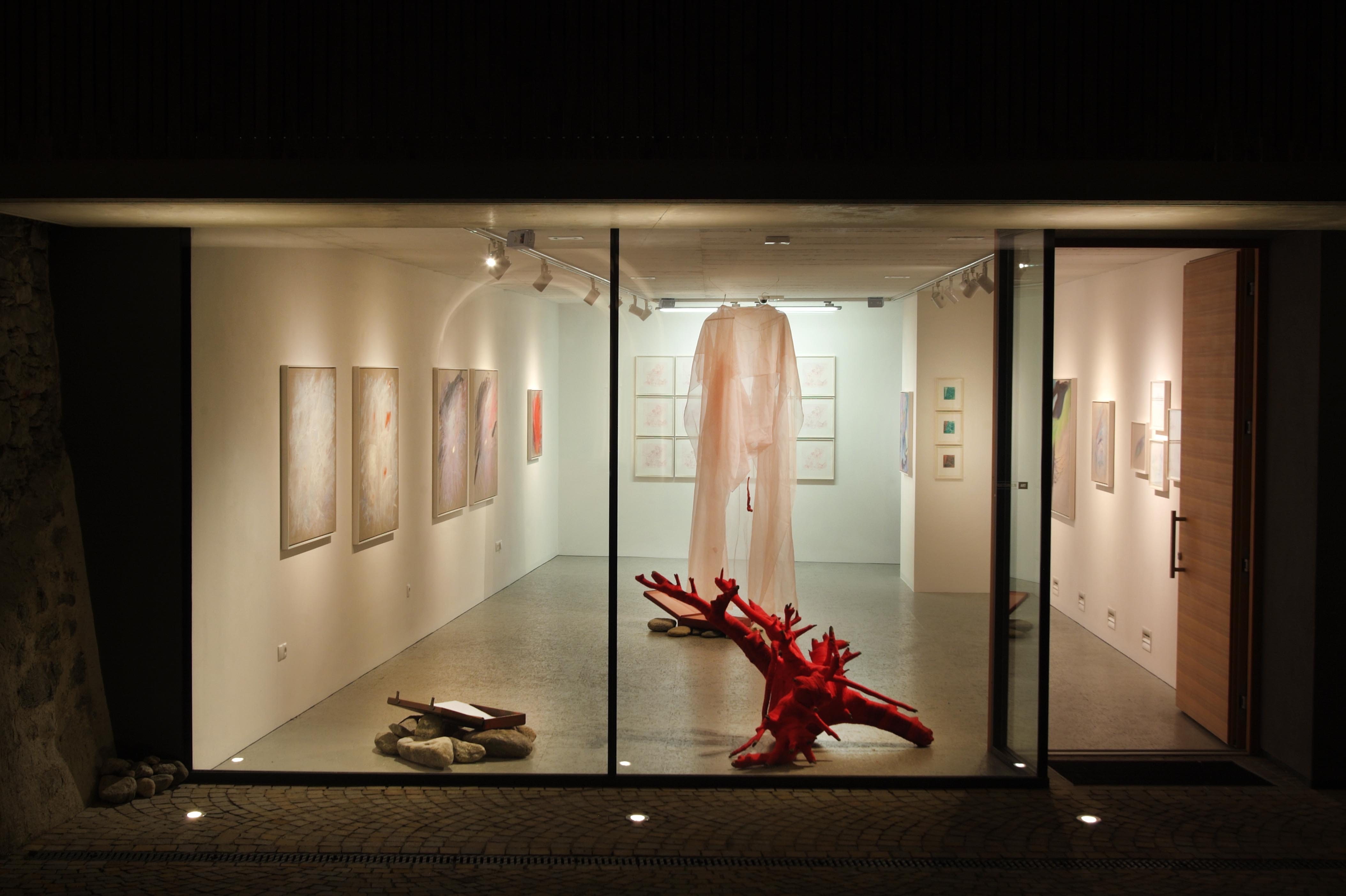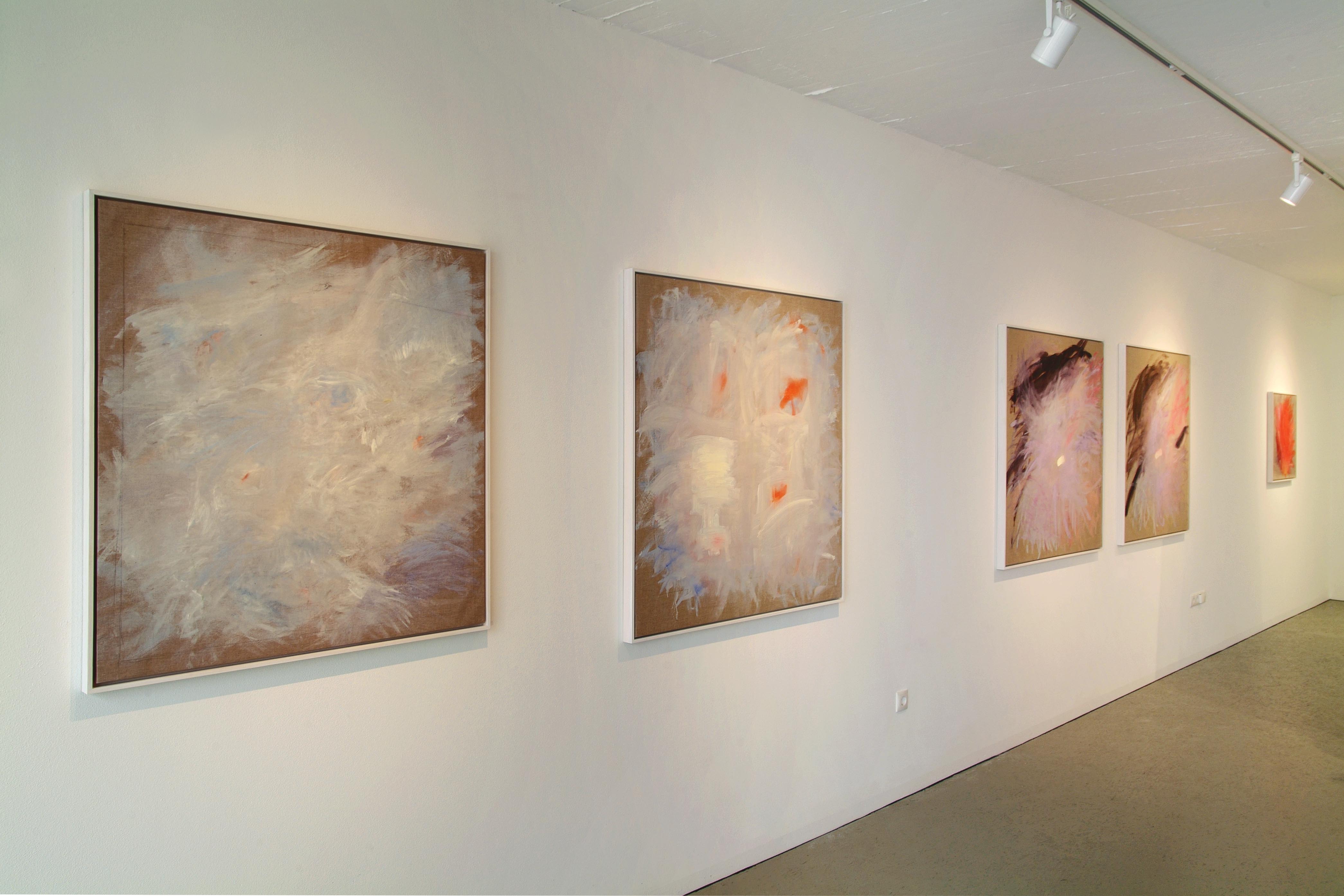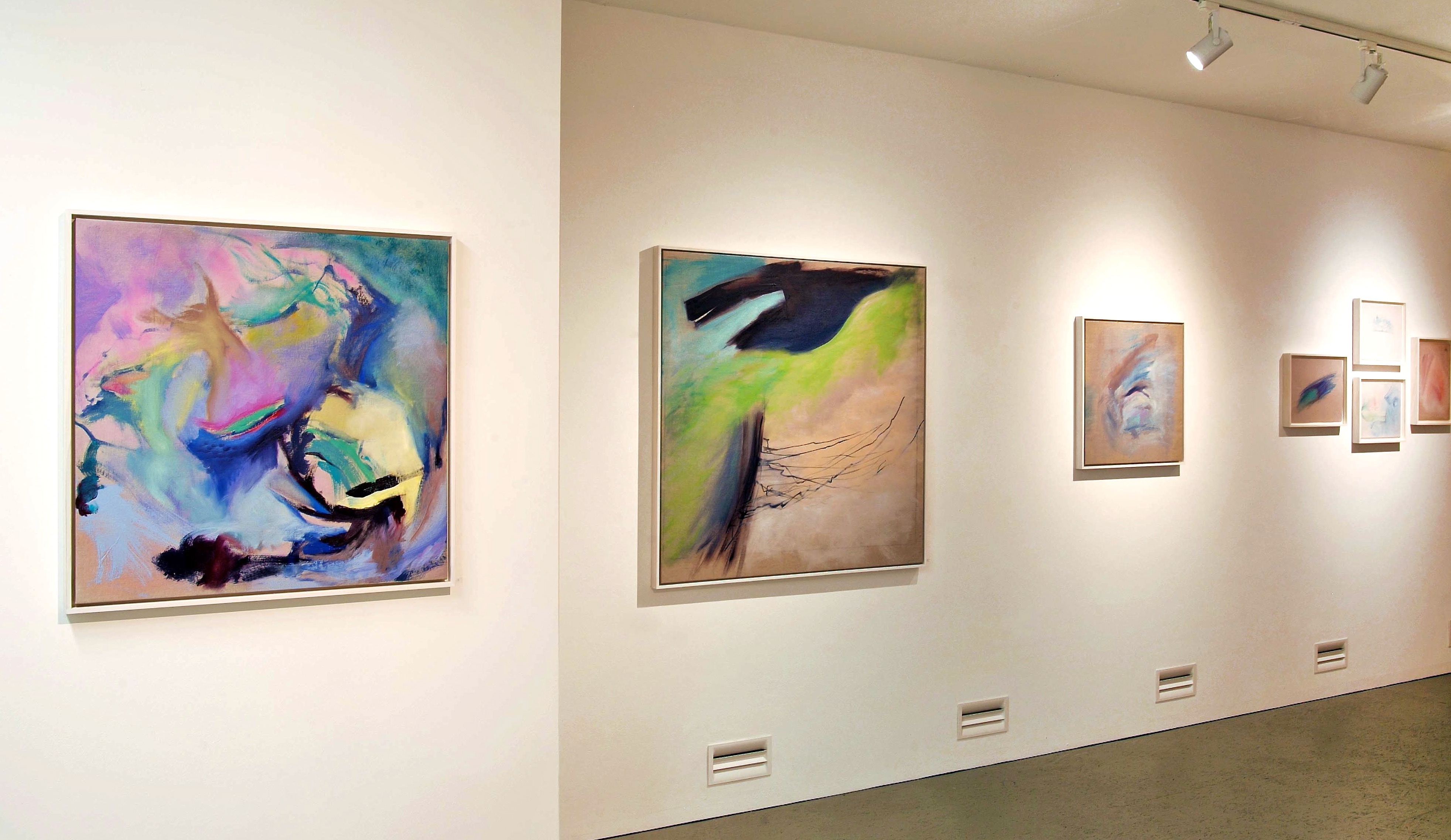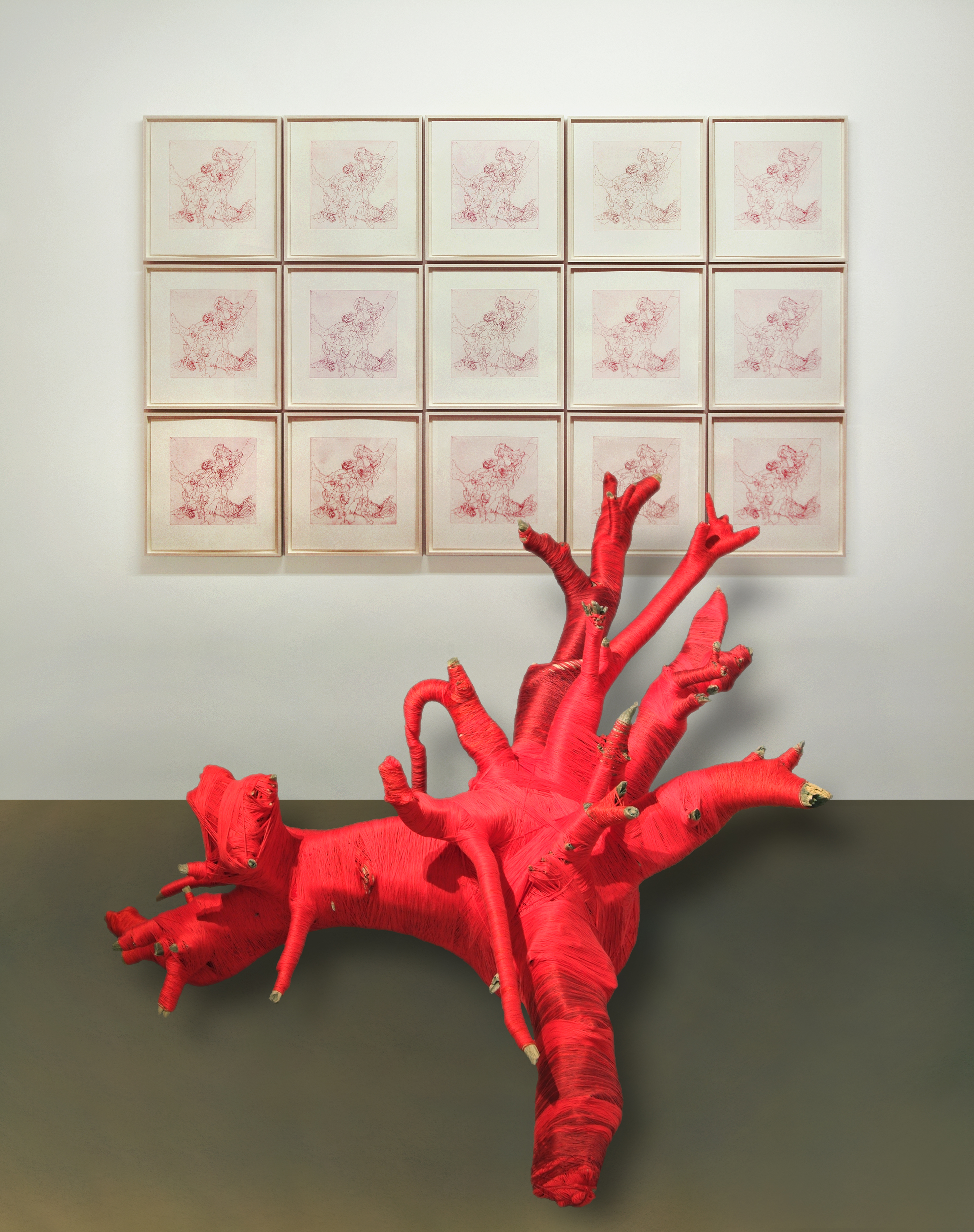



The Power of the Center
Sara Fontana
An artistic journey that seemed to have crystallized around painting is expanding into an exploration of other media. Painting, drawing, embroidery, installations, prints, papier collé collages, and artist’s books, traversed by writing and nourished by readings and heterogeneous visual sources, model a harmonious setting, hovering between the physical and the immaterial. It is a space in which Kikki Ghezzi hones her reflections on identity, strengthened by a new freedom and awareness. Pink is the predominant color, pink the experiences, images and objects that fill it, starting from a bewitching “femme-maison”.
The series of prints is an accentuation of that continuous reticular line refined in the latest drawings with “portraits” of roots, to which is added a study of color perception. Dialoguing with previous research is the new series of oil paintings -from Celestial Roots to I am That I Am to Power of the Center I and II -where memory traces have now been transfigured, arranged along a crest between naturalism and mysticism, and where the gesture and the action unleash centripetal forces, without ever slackening control over the composition. The artist then turns to the motif of the case, of a Duchamp-like memory and model, and develops two installations from it brought to life by the intervention of the visitor. Here we discover that the root has not in fact been dissolved into the image on the canvas. Present and tangible, it is merely waiting to be revealed. Into this dialectic of internal/external, visible/invisible, dream/reality are slotted the artistic figures who, according to Ghezzi, inspired this work of hers more than any others: in addition to the already-mentioned Marcel Duchamp -an almost obligatory evocation -are Georgia O’Keeffe and Louise Bourgeois, masters, in different ways, of letting the organic and the abstract rub shoulders, and of superimposing the female body on the forms and forces of the Earth and Nature.
Un percorso artistico che sembrava cristallizzato sulla pittura si sta espandendo nell’esplorazione di altri media. Pittura, disegno, ricamo, installazione, stampa, papier collé e libro d’artista, attraversati dalla scrittura e nutriti da letture e fonti visive eterogenee, plasmano un ambiente armonioso, librato tra fisicità e immaterialità. Uno spazio in cui Kikki Ghezzi affina le proprie riflessioni sull’identità, forte di una libertà e di una consapevolezza nuove. Rosa è il colore dominante, rosa sono i vissuti, le immagini e gli oggetti che la riempiono, a cominciare da un’ammaliante “femme-maison”.
La sequenza di stampe acuisce quel tratto continuo e reticolare messo a punto negli ultimi disegni con “ritratti” di radici, cui si somma lo studio sulla percezione cromatica. Dialoga con le precedenti ricerche anche la nuova serie di dipinti a olio – da Celestial Roots a I am That I Am a Power of the Center I e II -, dove le tracce della memoria sono ormai trasfigurate, assestate sul crinale fra naturalismo e misticismo, dove il gesto e l’azione scatenano forze centripete, senza allentare però il controllo sulla composizione.
L’artista torna poi sul motivo della valigetta, di memoria e modello duchampiani, e ne sviluppa due installazioni rese vive dall’intervento del visitatore. Qui si scopre che la radice non si è affatto dissolta sulla scena del quadro. Presente e tangibile, essa è soltanto in attesa di uno svelamento. In questa dialettica interno/esterno, visibile/invisibile, sogno/realtà s’inquadrano anche le figure artistiche che a detta della stessa Ghezzi hanno stimolato, più di altre, questo suo lavoro: oltre al citato Marcel Duchamp, passaggio quasi obbligato, Georgia O’Keeffe e Louise Bourgeois, maestre – in modi diversi – nel lasciar convivere organicità e astrazione e nel sovrapporre il corpo femminile alle forme/forze della terra e della natura.
The enracinement of Kikki Ghezzi
Ilaria Riccioni
According to Simone Weil, the enracinement is one of the deepest yearnings of the human soul, which the West systematically began to assault back in the early 1900s, undermining an invisible potential, universal community. For Weil, the enracinement, or the act of putting down roots, not only has a personal implication linked to the survival of the individual, but indicates how a physical place can respond to needs for spiritual nourishment, an impalpable interweaving of relationships which, starting from a personal level, operates in the universal. In this sense, Kikki Ghezzi’s work seems to hark back to that same need, even if triggered by quite different motives. This exhibition presents the artist’s observation of the process of re-elaborating her roots, a personal journey that becomes universal. The root as symbol and object becomes the guiding thread of a creative journey through which the artist questions herself -and us -on our origins and the need to be reborn from ourselves to acquire citizenship in change: what is the right distance from our roots? The ambivalent oscillation between the past, as the “first root” that nourishes, and personal experience directed towards the new, becomes necessary to “transform fears into love” and manifest these in a pictorial act that plays on the emotional power of colors. This process is underpinned by relentless work on memory that prepares for cosmic and universal consonance, leaving artistic acts and objects in its wake. The objects show Kikki Ghezzi’s artistic style: a “home-valise”, as an alchemical container that transforms the pictorial work into an artistic act, with a nod to Duchamp, and a “root-valise” in which territory becomes space, with memory traces transformed into new stimuli. On the road from rooting to uprooting are two witnesses: a printed mirror that documents changes without fixing them, letting them go, and a book drawn with sentimental strokes. Out of the second case comes a pink installation oriented towards the sky; in the heart of the installation sways a red root, suspended, uprooted; it seems to wish to manifest what is not normally visible, while still remaining earth-bound.
These may be invitations to reconsider the meaning of territory as space, of relationship as a changing action; the meaning of belonging enlarged as an idea of Franciscan brotherhood.
Omnia mea mecum porto, Kikki Ghezzi seems to be telling us, transforming an oft-tormented theme into a creative gesture traversed by dialoguing colors, numeric correspondences, prints of different colors; her case-containers are functional and symbolic objects representing both material uprooting and enracinement in the heart, within themselves; while serving also as carrying cases between the personal and the universal. It symbolizes a personal path re-inventing origins that seems to intuitively embrace the uprooting of globalized society, the complex identities that move within it, and the growing lack of territoriality in means of communication, including historical and political questions that the Alto Adige region incarnates as a borderland.
L’enracinement viene indicato da Simone Weil come una tra le più profonde esigenze dell’animo umano che l’Occidente, già dai primi anni del Novecento, inizia sistematicamente ad attentare, minando all’origine una potenziale e invisibile comunità universale. L’enracinement, o l’atto dell’essere radicati, per la Weil non ha solo un’implicazione personale legata alla sopravvivenza dell’individuo, ma richiama l’attenzione su come un luogo fisico risponda ad esigenze di nutrimento spirituale, un impalpabile tessuto di relazioni che, dal personale, opera nell’universale. In questo senso, il lavoro di Kikki Ghezzi sembra evocare quella stessa esigenza, sebbene avviata da altri moventi. La mostra presenta l’osservazione dell’artista del suo stesso processo di ri-elaborazione delle radici. Un percorso personale che si fa universale. La radice come simbolo e oggetto diventa il filo rosso di un percorso creativo attraverso il quale l’artista si interroga, e ci interroga, sulle origini e sul bisogno di rinascere da se stessi per prendere cittadinanza nel mutamento: qual è la giusta distanza dalle proprie radici? L’oscillazione ambivalente tra il passato, come “prima radice”, che nutre, e il vissuto personale, rivolto al nuovo, si fa necessaria per “trasformare le paure in amore” e manifestarle in atto pittorico che gioca con la forza emotiva dei colori. Fa da sfondo il lavoro costante sulla memoria che prepara ad una consonanza cosmica e universale, lasciando come tracce atti e oggetti artistici. Gli oggetti mostrano la cifra del lavoro artistico di Kikki Ghezzi: la valigetta-casa, come contenitore alchemico, trasforma il lavoro pittorico in atto artistico, citando Duchamp. Una valigetta-radice nella quale il territorio diventa spazio, con tracce di memoria trasformate in nuovi stimoli. Nel percorso tra radicamento e sradicamento sono testimoni uno specchio stampato che documenta i cambiamenti, ma non li fissa, li lascia andare, e un libro disegnato di tracce affettive. Dalla seconda valigetta ha origine un’installazione rosa orientata al cielo; nel cuore dell’installazione “ciondola” una radice rossa, sospesa, sradicata, che sembra voler manifestare ciò che, di regola, non è visibile, rimanendo parte della terra.
Sono forse inviti al ripensamento del significato del territorio come spazio, della relazione come azione in mutamento, del significato di appartenenza allargata come idea di francescana fratellanza.
Omnia mea mecum porto, sembra dirci giocosamente Kikki Ghezzi trasformando una tematica spesso sofferta in un gesto creativo percorso da colori in dialogo, da corrispondenze numeriche, stampe in variazioni cromatiche, contenitori-valigetta: oggetto funzionale e simbolico dello sradicamento materiale e l’inradicamento nel cuore, contenitore che opera tra il personale e l’universale. Un percorso personale di re-invenzione delle origini che sembra accogliere intuitivamente lo sradicamento della società globalizzata, le identità complesse che in essa si muovono e la crescente a-territorialità dei mezzi di comunicazione, fino alle questioni storiche e politiche che il territorio altoatesino incarna come confine.